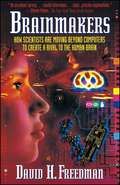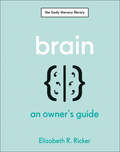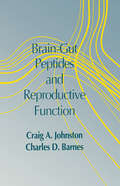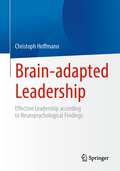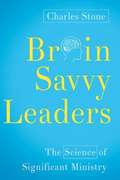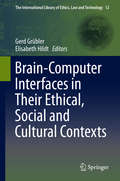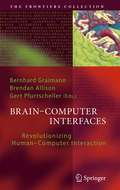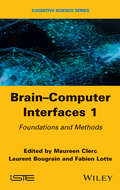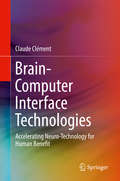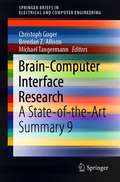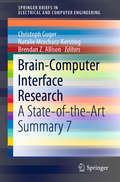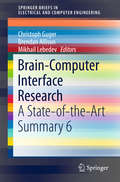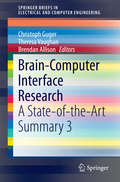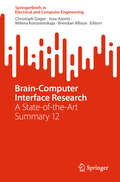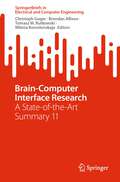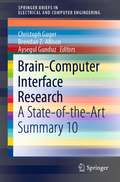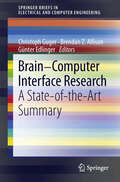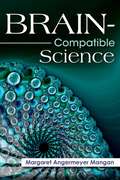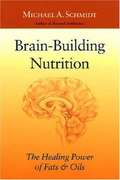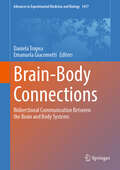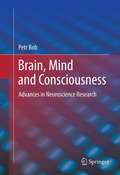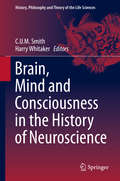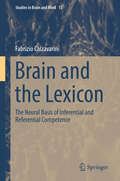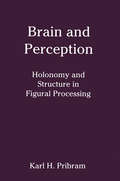- Table View
- List View
Brainmakers
by David FreedmanHOW SCIENTISTS ARE MOVING BEYOND COMPUTERS TO CREATE A RIVAL TO THE HUMAN BRAIN
Brain: An Owner's Guide (The Body Literacy Library)
by Elizabeth R. RickerBecome body literate with Brain: An Owner's Guide, the next book in The Body Literacy Library, an enlightening series that democratizes health for a new generation of readers.Brain: An Owner’s Guide is an informative and practical guide to all aspects of brain health, from maximizing your mental well-being today to protecting your brain against future serious health issues. Leading neuroscientist Eli Ricker explains how the brain works, discusses how you can take care of and protect your brain, and explains what you can do to improve your memory and concentration at any age. Ricker also looks at what constitutes mental "well-being" and the science behind a positive mindset, resilience, concentration, and memory, as well as low mood, depression, and brain fog. Dementia and other brain disorders are a huge concern for many, and Ricker looks at how these occur, the latest medical research, and what you can do to protect your brain for life.Author Elizabeth Ricker is an engaging and media-friendly neuroscientist who specializes in brain health research, with a particular emphasis on brain "hacking," memory, and concentration. She translates medical jargon into simple, clear prose, answering frequently asked patient queries, such as "How can I improve my concentration?," "Do brain games work?," "Is dementia hereditary?," "What is good brain food?," "Why do I have brain fog?," and much more.From the importance of sleep and stress management to why dementia is a feminist issue, this hardworking book applies science to the everyday, with simple illustrations, checklists, FAQs, and myth busters, all supported by the latest medical research. Brain: An Owner’s Guide can help you better understand your mind and aims to enhance your long-term quality of life.
Brain-gut Peptides and Reproductive Function
by Craig Johnston Charles D. BarnesThis book elucidates the role of brain-gut peptides in neuroendocrine regulation for understanding how these peptides interact with the reproductive neuroendocrine axis and for developing novel therapeutic agents for fertility or contraceptive therapies.
Brain-adapted Leadership: Effective Leadership according to Neuropsychological Findings
by Christoph HoffmannThe book shows you how you can effectively integrate the latest findings of neuroscience into your everyday work or leadership. Brain-adapted leadership shows you how applied psychology from the perspective of neuroscience works both in leadership work and in everyday professional life as a whole. Based on a neuropsychological behavioral model, you will learn about the plausible connections between perceptions, needs, emotions, thinking and acting. These insights form a valuable basis for leading yourself, teams and corporate units. In addition, you will receive numerous exercise instructions and examples for illustration and practical implementation. The subject of this work is of particular importance to you if you want to better understand your own feelings and behavior and those of your fellow human beings in order to achieve valuable interactions and fulfilling work activities. Target Audience:This reference book is aimed at managers and coaches, as well as people in the world of work who are willing to work on themselves to achieve greater satisfaction, serenity and balance: and neuroscience knows that we can do this, even into old age. About the author: Christoph Hoffmann is a graduate psychologist FH, graduate engineer HTL; studied psychology with a focus on Industrial and Organizational Psychology in Zurich. He has leadership experience in various adult education institutions and works at the IAP at the ZHAW Zurich University of Applied Sciences as a consultant and lecturer in the Centre for Leadership, Coaching and Change Management.
Brain-Savvy Leaders: The Science of Significant Ministry
by Charles StoneLeadershipdemands constant reframing and reappraisal of the situation at hand. Itrequires focus, objectivity, honest appraisal of self and others, andevaluation of available resources. An effective Christian church leadermust also align the congregation’s vision and practices with God’svision and the teachings of Christ. Perhaps most importantly, the churchleader must love others.AuthorCharles Stone uses recent neuroscience research to show how basic brainprocesses affect leadership. He writes in layperson’s language, withmemory-boosting illustrations and acronyms, helping readers to increaseproductivity, handle stress, create and sustain healthy teams, andmanage change in the church. Brain science complements and reinforcesChristian teaching on life and leadership; Brain-Savvy Leaders equips readers to use that science as a tool for improvement for life and for the church. Brain-Savvy Leaders is……the best book I have read on the brain science of healthy thinking andeffective leadership. Dr. Stone has done an incredible job of balancingmodern brain science with Biblical truth, making complex ideas simple tounderstand and providing practical tools to enhance mental performance.--Timothy R. Jennings, M.D, FAPA; President, Tennessee PsychiatricAssociation; Vice President, Southern Psychiatric Association; author, The God Shaped Brain: How Changing Your View of God Transforms Your Life…an engaging and fun read that's also insightful, informative, andpractical. A valuable resource for spiritual leaders. --Golnaz Tabinia,neuroscientist and assistant professor, Carnegie Mellon University…will help you with emotional regulation, personal productivity, teamcollaboration and change management. It's a winner! --Dan Reiland,Executive Pastor, 12Stone Church, Lawrenceville, Georgia; author, Amplified Leadership…shares helpful tips on how to master leadership in the church. I neededthis book. --Ron Edmondson, Senior Pastor, Immanuel Baptist Church,Lexington, Kentucky…can help you take your church to the next level and help you betteralign your leadership with God's desires. It will help you achievegreater focus and design more cohesive and collaborative teams. I highlyrecommend it. --Jeffrey M. Schwartz, M.D., author of You Are Not Your Brain and Brain Lock
Brain-Computer-Interfaces in their ethical, social and cultural contexts (The International Library of Ethics, Law and Technology #12)
by Elisabeth Hildt Gerd GrüblerThis volume summarizes the ethical, social and cultural contexts of interfacing brains and computers. It is intended for the interdisciplinary community of BCI stakeholders. Insofar, engineers, neuroscientists, psychologists, physicians, care-givers and also users and their relatives are concerned. For about the last twenty years brain-computer-interfaces (BCIs) have been investigated with increasing intensity and have in principle shown their potential to be useful tools in diagnostics, rehabilitation and assistive technology. The central promise of BCI technology is enabling severely impaired people in mobility, grasping, communication, and entertainment. Successful applications are for instance communication devices enabling locked-in patients in staying in contact with their environment, or prostheses enabling paralysed people in reaching and grasping. In addition to this, it serves as an introduction to the whole field of BCI for any interested reader.
Brain-Computer Interfaces: Revolutionizing Human-Computer Interaction (The Frontiers Collection #6)
by Gert Pfurtscheller Bernhard Graimann Brendan Z. AllisonA brain-computer interface (BCI) establishes a direct output channel between the human brain and external devices. BCIs infer user intent via direct measures of brain activity and thus enable communication and control without movement. This book, authored by experts in the field, provides an accessible introduction to the neurophysiological and signal-processing background required for BCI, presents state-of-the-art non-invasive and invasive approaches, gives an overview of current hardware and software solutions, and reviews the most interesting as well as new, emerging BCI applications. The book is intended not only for students and young researchers, but also for newcomers and other readers from diverse backgrounds keen to learn about this vital scientific endeavour.
Brain-Computer Interfaces 1: Methods and Perspectives
by Fabien Lotte Laurent Bougrain Maureen ClercBrain-computer interfaces (BCI) are devices which measure brain activity and translate it into messages or commands, thereby opening up many investigation and application possibilities. This book provides keys for understanding and designing these multi-disciplinary interfaces, which require many fields of expertise such as neuroscience, statistics, informatics and psychology. This first volume, Methods and Perspectives, presents all the basic knowledge underlying the working principles of BCI. It opens with the anatomical and physiological organization of the brain, followed by the brain activity involved in BCI, and following with information extraction, which involves signal processing and machine learning methods. BCI usage is then described, from the angle of human learning and human-machine interfaces. The basic notions developed in this reference book are intended to be accessible to all readers interested in BCI, whatever their background. More advanced material is also offered, for readers who want to expand their knowledge in disciplinary fields underlying BCI. This first volume will be followed by a second volume, entitled Technology and Applications
Brain-Computer Interface Technologies: Accelerating Neuro-Technology for Human Benefit
by Claude ClémentThis book is about the field of brain-computer interfaces (BCI) and the unique and special environment of active implants that electrically interface with the brain, spinal cord, peripheral nerves, and organs. At the heart of the book is the matter of repairing and rehabilitating patients suffering from severe neurologic impairments, from paralysis to movement disorders and epilepsy, that often requires an invasive solution based on an implanted device. Past achievements, current work, and future perspectives of BCI and other interactions between medical devices and the human nervous system are described in detail from a pragmatic point of view.Reviews the Active Implantable Medical Devices (AIMDs) industry and how it is moving from cardiac to neuro applicationsClear, easy to read, presentation of the field of neuro-technologies for human benefitProvides easy to understand explanations about the technical limitations, the physics of implants in the human body, and realistic long terms perspectives
Brain-Computer Interface Research: A State-of-the-Art Summary 9 (SpringerBriefs in Electrical and Computer Engineering)
by Brendan Z. Allison Christoph Guger Michael TangermannThe Annual BCI Research Awards are international prizes that recognize the top new projects in brain–computer interface (BCI) research. This book contains concise descriptions of projects nominated for the 2019 BCI Research Award and interviews with nominees. Each article is authored by the researchers who developed the project, and articles have been updated with new progress achieved since their nomination. These chapters are complemented by an introduction by the editors together with a concluding chapter that reviews the annual Awards Ceremony, announces the winners, and ends with a brief discussion.One of the prominent trends in recent years has been the development of BCIs for new patient groups. Many chapters in this book present emerging and novel research directions likely to become more prevalent in the near future. This year's book includes chapters based on interviews with BCI experts who were nominated for an award, including this year's first, second, and third place winners. These interview chapters are generally less technical than project descriptions, and provide individual perspectives from people actively working on new methods and systems.
Brain-Computer Interface Research: A State-of-the-Art Summary 7 (SpringerBriefs in Electrical and Computer Engineering #6)
by Brendan Z. Allison Christoph Guger Natalie Mrachacz-KerstingEach year, the Annual BCI Research Award recognizes the top new projects in brain-computer interface (BCI) research. This book contains summaries of these projects from the 2017 BCI Research Award. Each chapter is written by the group that submitted the BCI project that was nominated, and introduction and discussion chapters provide supporting information and explore trends that are reflected in the annual awards each year. One of the prominent trends in recent years has been BCIs for new patient groups, and many chapters in this book present emerging research directions that might become more prevalent in the near future.
Brain-Computer Interface Research: A State-of-the-Art Summary 6 (SpringerBriefs in Electrical and Computer Engineering #6)
by Brendan Allison Christoph Guger Mikhail LebedevBrain-computer interfaces (BCIs) are rapidly developing into a mainstream, worldwide research endeavor. With so many new groups and projects, it can be difficult to identify the best ones. This book summarizes ten leading projects from around the world. About 60 submissions were received in 2011 for the highly competitive BCI Research Award, and an international jury selected the top ten. This Brief gives a concise but carefully illustrated and fully up-to-date description of each of these projects, together with an introduction and concluding chapter by the editors.
Brain-Computer Interface Research: A State-of-the-Art Summary 3 (SpringerBriefs in Electrical and Computer Engineering #6)
by Brendan Allison Christoph Guger Theresa VaughanThis book provides a cutting-edge overview of the latest developments in Brain-Computer-Interfaces (BCIs), reported by leading research groups. As the reader will discover, BCI research is moving ahead rapidly, with many new ideas, research initiatives, and improved technologies, e. g. BCIs that enable people to communicate just by thinking - without any movement at all. Several different groups are helping severely disabled users communicate using BCIs, and BCI technology is also being extended to facilitate recovery from stroke, epilepsy, and other conditions. Each year, hundreds of the top BCI scientists, engineers, doctors, and other visionaries compete for the most prestigious honor in the BCI research community: the annual BCI Award. The 2013 BCI Award competition was by far the most competitive, with over 160 research groups vying for a nomination. The chapters of this book summarize the ten projects that were nominated, in particular the winning project, and analyses how these reflect general trends in BCI development. Each project summary includes an introduction, description of methods, results, and also includes newer work completed after the project was entered for the competition. The texts are presented in accessible style with numerous supporting pictures, graphs, and figures.
Brain-Computer Interface Research: A State-of-the-Art Summary 12 (SpringerBriefs in Electrical and Computer Engineering)
by Brendan Allison Christoph Guger Milena Korostenskaja Jose AzorinThis book showcases recent trends in brain-computer interface development. It highlights fascinating results in areas such as speech neuroprotheses, bionic hands, memory enhancement, and the development of optical BCIs . The contributions describe the three winning projects and other nominated brain-computer interface projects selected by the expert international jury of the BCI Award 2023. In the book, each project is described in detail by the team of scientists behind it, and the editors provide a concluding discussion of the highlights and overall progress in the field.
Brain-Computer Interface Research: A State-of-the-Art Summary 11 (SpringerBriefs in Electrical and Computer Engineering)
by Brendan Allison Christoph Guger Tomasz M. Rutkowski Milena KorostenskajaThis book showcases recent trends in brain-computer interface development. It highlights fascinating results in areas such as language decoding, spinal cord stimulation to enable gait and to restore hand functions. The contributions are based on the 12 nominated brain-computer interface projects of the BCI Award 2022. Every year an international jury selects the most innovate BCI projects and nominates 12 projects before selecting the 1st, 2nd and 3rd place winners. In the book, each project is described in detail by the team of scientists behind it, and the editors provide a concluding discussion of the highlights and overall progress in the field.
Brain-Computer Interface Research: A State-of-the-Art Summary 10 (SpringerBriefs in Electrical and Computer Engineering)
by Brendan Z. Allison Christoph Guger Aysegul GunduzThe Annual BCI Research Awards are international prizes that recognize the top new projects in brain–computer interface (BCI) research. This book contains concise descriptions of projects nominated for the 2020 BCI Research Award and interviews with nominees. Each article is authored by the researchers who developed the project, and articles have been updated with new progress achieved since their nomination. These chapters are complemented by an introduction by the editors together with a concluding chapter that reviews the annual Awards Ceremony, announces the winners, and ends with a brief discussion.One of the prominent trends in recent years has been the development of BCIs for restoring limb use and for aiding optical and auditory sensory perception. Many chapters in this book present emerging and novel research directions likely to become more prevalent in the near future. This year's book includes chapters based on interviews with BCI experts who were nominated for an award, including this year's first, second, and third place winners. These interview chapters are generally less technical than project descriptions, and provide individual perspectives from people actively working on new methods and systems.
Brain-Computer Interface Research: A State-of-the-Art Summary (SpringerBriefs in Electrical and Computer Engineering #6)
by Brendan Z. Allison Christoph Guger Günter EdlingerBrain-computer interfaces (BCIs) are rapidly developing into a mainstream, worldwide research endeavor. With so many new groups and projects, it can be difficult to identify the best ones. This book summarizes ten leading projects from around the world. About 60 submissions were received in 2011 for the highly competitive BCI Research Award, and an international jury selected the top ten. This Brief gives a concise but carefully illustrated and fully up-to-date description of each of these projects, together with an introduction and concluding chapter by the editors.
Brain-Compatible Science
by Margaret Angermeyer ManganGain fresh insights for teaching, learning, and assessing knowledge of critical science concepts through the exploration of research-based practices for science education.
Brain-Building Nutrition: How Dietary Fats and Oils Affect Mental, Physical, and Emotional Intelligence
by Michael SchmidtThis provides a host of practical dietary information and new, groundbreaking research to support the author's findings. A remarkable but little known fact is that the brain is nearly 60 percent fat.
Brain-Body Connections: Bidirectional Communication Between the Brain and Body Systems (Advances in Experimental Medicine and Biology #1477)
by Daniela Tropea Emanuela GiacomettiThis book offers a broad exploration of the intricate networks that facilitate communication between the brain and various systems in the body. At the heart of this volume is the examination of how these connections influence both physiological and pathological outcomes. The first two chapters of the book describe the Blood Brain Barrier (BBB) and the interaction of the brain with the peripheral nervous system. The following chapters delve into the reciprocal communication of the brain and the circulatory, immune, metabolic and digestive systems and discuss the impact of these communication mechanisms on human health and disease. Contributions from leading experts provide a detailed analysis of these complex interactions, making this book a must-read for anyone interested in the molecular underpinnings of brain-body communication. Researchers, scholars, and students in neuroscience, physiology, and related fields will find this book invaluable. It not only enhances understanding of the brain's role in regulating bodily functions but also offers insights into potential therapeutic targets for various disorders. This volume is an essential addition to any scientific library.
Brain, Mind and Consciousness: Advances in Neuroscience Research
by Petr BobNeuropsychological research on the neural basis of behavior generally asserts that brain mechanisms ultimately suffice to explain all psychologically described phenomena. This assumption stems from the idea that the brain consists entirely of material particles and fields, and that all causal mechanisms relevant to neuroscience can be formulated solely in terms of properties of these elements. Contemporary basic physical theory differs from classic physics on the important matter of how consciousness of human agents enters into the structure of empirical phenomena. The new principles contradict the older idea that local mechanical processes alone account for the structure of all empirical data. Contemporary physical theory brings directly into the overall causal structure certain psychologically described choices made by human agents about how they will act. This key development in basic physical theory is applicable to neuroscience. This book explores this new framework.
Brain, Mind and Consciousness in the History of Neuroscience (History, Philosophy and Theory of the Life Sciences #6)
by C. U. M. Smith Harry WhitakerThis volume of essays examines the problem of mind, looking at how the problem has appeared to neuroscientists (in the widest sense) from classical antiquity through to contemporary times. Beginning with a look at ventricular neuropsychology in antiquity, this book goes on to look at Spinozan ideas on the links between mind and body, Thomas Willis and the foundation of Neurology, Hooke's mechanical model of the mind and Joseph Priestley's approach to the mind-body problem. The volume offers a chapter on the 19th century Ottoman perspective on western thinking. Further chapters trace the work of nineteenth century scholars including George Henry Lewes, Herbert Spencer and Emil du Bois-Reymond. The book covers significant work from the twentieth century, including an examination of Alfred North Whitehead and the history of consciousness, and particular attention is given to the development of quantum consciousness. Chapters on slavery and the self and the development of an understanding of Dualism bring this examination up to date on the latest 21st century work in the field. At the heart of this book is the matter of how we define the problem of consciousness itself: has there been any progress in our understanding of the working of mind and brain? This work at the interface between science and the humanities will appeal to experts from across many fields who wish to develop their understanding of the problem of consciousness, including scholars of Neuroscience, Behavioural Science and the History of Science.
Brain and the Lexicon: The Neural Basis of Inferential and Referential Competence (Studies in Brain and Mind #15)
by Fabrizio CalzavariniThis monograph offers a novel, neurocognitive theory concerning words and language. It explores the distinction between inferential and referential semantic competence. The former accounts for the relationship of words among themselves, the latter for the relationship of words to the world. The author discusses this distinction at the level of the human brain on both theoretical and neuroscientific grounds. In addition, this investigation considers the relation between the inf/ref neurocognitive theory and other accounts of semantic cognition proposed in the field of neurosemantics, as well as some potential implications of the theory for clinical neuroscience and the philosophy of semantics. Overall, the book offers an important contribution to the debate about lexical semantic competence. It combines a strong philosophical and linguistic background with a comprehensive and critical analysis of neurosemantic literature. Topics discussed lie at the intersection of philosophical semantics, linguistics, neurolinguistics, cognitive science, artificial intelligence, cognitive neuroscience, and clinical psychology. Due to its interdisciplinary orientation, coverage is rich in introductory remarks and not overly technical, therefore it is accessible to non-experts as well.
Brain and Perception: Holonomy and Structure in Figural Processing (Distinguished Lecture Series)
by Karl H. PribramPresented as a series of lectures, this important volume achieves four major goals: 1) It integrates the results of the author's research as applied to pattern perception -- reviewing current brain research and showing how several lines of inquiry have been converging to produce a paradigm shift in our understanding of the neural basis of figural perception. 2) It updates the holographic hypothesis of brain function in perception. 3) It emphasizes the fact that both distributed (holistic) and localized (structural) processes characterize brain function. 4) It portrays a neural systems analysis of brain organization in figural perception by computational models -- describing processing in terms of formalisms found useful in ordering data in 20th-century physical and engineering sciences. The lectures are divided into three parts: a Prolegomenon outlining a theoretical framework for the presentation; Part I dealing with the configural aspects of perception; and Part II presenting its cognitive aspects. The appendices were developed in a collaborative effort by the author, Kunio Yasue, and Mari Jibu (both of Notre Dame Seishin University of Okayama, Japan).
Brain and Music
by Stefan KoelschA comprehensive survey of the latest neuroscientific research into the effects of music on the brainCovers a variety of topics fundamental for music perception, including musical syntax, musical semantics, music and action, music and emotionIncludes general introductory chapters to engage a broad readership, as well as a wealth of detailed research material for expertsOffers the most empirical (and most systematic) work on the topics of neural correlates of musical syntax and musical semanticsIntegrates research from different domains (such as music, language, action and emotion both theoretically and empirically, to create a comprehensive theory of music psychology
